Structural Properties, Natural Bond Orbital, Theory Functional Calculations (DFT), and Energies for the α Halorganic Compounds
Najla Seidy1 * and Shahriar Ghammamy1
DOI: http://dx.doi.org/10.12944/CWE.7.2.05
Copy the following to cite this article:
Seidy N, Ghammamy S. Structural Properties, Natural Bond Orbital, Theory Functional Calculations (DFT), and Energies for the α Halorganic Compounds. Curr World Environ 2012;7(2):221-226 DOI:http://dx.doi.org/10.12944/CWE.7.2.05
Copy the following to cite this URL:
Seidy N, Ghammamy S. Structural Properties, Natural Bond Orbital, Theory Functional Calculations (DFT), and Energies for the α Halorganic Compounds. Curr World Environ 2012;7(2):221-226. Available from: http://www.cwejournal.org/?p=2779
Download article (pdf) Citation Manager Publish History
Select type of program for download
| Endnote EndNote format (Mac & Win) | |
| Reference Manager Ris format (Win only) | |
| Procite Ris format (Win only) | |
| Medlars Format | |
| RefWorks Format RefWorks format (Mac & Win) | |
| BibTex Format BibTex format (Mac & Win) |
Article Publishing History
| Received: | 2012-07-12 |
|---|---|
| Accepted: | 2012-09-17 |
Organic halogen alkane compounds or halocarbon compounds are chemicals in which one or morecarbonatoms are linked by covalent bonds with one or more halogenatoms (fluorine, chlorine, bromine or iodine - group 17) resulting in the formation of organofluorine compounds, organochlorine compounds, organobromine compounds, and organoiodine compounds. Chlorine halocarbons are the most common and are called organochlorides. Many synthetic organic compounds such as plasticpolymers, and a few natural ones, contain halogen atoms; they are known as halogenated compounds or organohalogens. Organochlorides are the most common industrially used organohalides, although the other organohalides are used commonly in organic synthesis. Except for extremely rare cases, organohalides are not produced biologically, but many pharmaceuticals are organohalides. Organic halogen compounds have many used in theoretical and industrial [1-4].Common uses for halocarbons have been as solvents, pesticides, refrigerants, fire-resistant oils, ingredients of elastomers, adhesives and sealants, electrically insulating coatings, plasticizers, and plastics. Many halocarbons have specialized uses in industry. One halocarbon, sucralose, is a sweetener. Many different data have been found about the structural properties of halo compounds, but they are insufficient and opposing in somewhere.The investigation of the structures and properties of the compound and similarities are interested. The structure has been confirmed by neutron diffraction studies and is justified by VSEPR theory [5-8]. During this study we report the optimized geometries, assignments and electronic structure calculations for the compound. The structure of the compound has been optimized by using the DFT (B3LYP) method with the LANL2DZbasis sets, using the Gaussian 09 program [9]. The comparison between theory and experiment is made. Density functional theorymethods were employed to determine the optimized structures of C3H2F4Br2and Initial calculations were performed at the DFT level and split- valence plus polarization LANL2DZbasis sets were used. Local minima were obtained by full geometrical optimization have all positive frequencies [10].
Methods
All computational are carried out using Gaussian 09 program [11]. The optimized structural parameters were used in the vibrational frequency calculations at the HF and DFT levels to characterize all stationary points as minima. Harmonic vibrational frequencies (ν) in cm-1 and infrared intensities (int) in Kilometer per mole of all compounds were performed at the same level on the respective fully optimized geometries. Energy minimum molecular geometries were located by minimizing energy, with respect to all geometrical coordinates without imposing any symmetrical constraints.
Results and Discussion Molecular properties
The structures of compounds are shown in Figure 1. All calculations were carried out using the computer program GAUSSIAN 09. Theoretical calculation of bond and angle for the compound was determined by optimizing the geometry (Table 1). NBO Analysis in Table1 and The NBO Calculated Hybridizations are reported in Table2. We could not compare the calculation results given in bond lengths and bond angle values with the experimental data. Because the crystal structure of the title compound is not available till now. B3LYP/LANL2DZcalculation results showed that the (C1-F6) bond length values for the C3H2F4Br2 and in compounds 1-2 are 1.3909 Å and 1.3765 Å respectively.And (C-Br-) bond length values for the C3H2F4Br2compounds 1-2 are 1.8031Åand 1.7727Å respectively. Alkyl halide compounds are mostly dense liquids and solids that are insoluble in water. The halogens are all more electronegative than carbon and this makes the carbon-halogen bond a polar bond with a slight positive charge (d +) residing on the carbon end of
the bond and a slight negative charge (d-) on the halogen end.
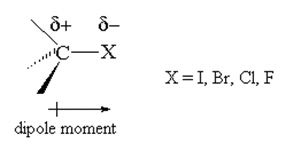
The carbon-halogen bond strength decreases in the order C-F > C-Cl > C-Br > C-I Alkyl fluorides tend to be less reactive than other alkyl halides, mainly due to the higher strength of the C-F bond.
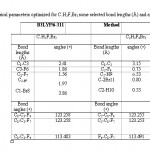 |
Table 1: Geometrical parameters optimized for C3H2F4Br2 some selected bond lengths (Å) and angles (°C) Click here to View table |
NBO study on structures
Natural Bond Orbital's (NBOs) are localized few-center orbital's that describe the Lewis-like molecular bonding pattern of electron pairs in optimally compact form. More precisely, NBOs are an orthonormal set of localized "maximum occupancy" orbital's whose leading N/2 members (or N members in the open-shell case) give the most accurate possible Lewis-like description of the total N-electron density. This analysis is carried out by examining all possible interactions between "filled" (donor) Lewis-type NBOs and "empty" (acceptor) non-Lewis NBOs, and estimating their energetic importance by 2nd-order perturbation theory. Since these interactions lead to donation of occupancy from the localized NBOs of the idealized Lewis structure into the empty non-Lewis orbitals (and thus, to departures from the idealized Lewis structure description), they are referred to as "delocalization" corrections to the zeroth-order natural Lewis structure. Natural charges have been computed using natural bond orbital (NBO) module implemented in Gaussian09.The NBO Calculated Hybridizations are significant parameters for our investigation. These quantities are derived from the NBO population analysis.The former provides an orbital picture that is closer to the classical Lewis structure.The NBO analysis involving hybridizations of selected bonds are calculated at B3LYP methods and LANL2DZ level of theory (Table 2).
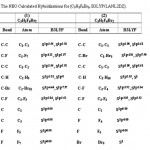 |
Table 2: The NBO Calculated Hybridizations for (C3H2F4Br2, B3LYP/LANL2DZ) Click here to View table |
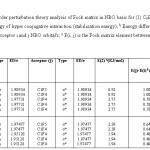 |
Table 3: Second order perturbation theory analysis of Fock matrix in NBO basis for (1) C3H2F4Br2 (2))a means energy of hyper conjugative interaction (stabilization energy); b Energy difference between donor and acceptor i and j NBO orbital’s; c F(i, j) is the Fock matrix element between i and j NBO Click here to View table |
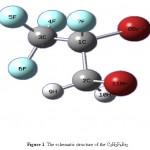 |
Fig. 1: The schematic structure of the C3H2F4Br2 Click here to View figure |
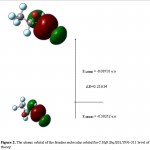 |
Fig. 2: The atomic orbital of the frontier molecular orbital for C3H2F4Br2 B3LYP/6-311 level of theory Click here to View figure |
These data shows the hyper conjugation of electrons between ligand atoms with central metal atom. These conjugations stand on the base of p-d π-bonding. The NBO calculated hybridization for C3H2F4Br2 shows that all of complexes have SPX hybridization and non planar configurations. The total hybridization of these molecules are SPX that confirmed by structural. The amount of bond hybridization showed the in equality between central atoms angles (Table 2) Shown distortion from octahedral and VSEPR structural and confirmed deviation from VSEPR structures. In C3H2F4Br2 the lone pair located on bromin atoms and significantly delocalized hybrid orbital's of C-F bonds. Indeed, in the interaction energy from the charge transfersC3H2F4Br2complex confirms the above point and in the average for C3H2F4Br2 the maximum interaction energy is predicted (Table 3).
Frontier molecular orbital
Both the highest occupied molecular orbital (HOMO) and lowest unoccupied molecular orbital (LUMO) are the main orbital take part in chemical stability. The HOMO represents the ability to donate an electron, LUMO as an electron acceptor represents the ability to obtain an electron. The HOMO and LUMO energy were calculated by B3LYP/LANL2DZ method [12]. This electronic absorption corresponds to the transition from the ground to the first excited state and is mainly described by one electron excitation from the highest occupied molecular or orbital (LUMO). Therefore, while the energy of the HOMO is directly related to the ionization potential, LUMO energy is directly related to the electron affinity. Energy difference between HOMO and LUMO orbital is called as energy gap that is an important stability for structures. In addition, 3D plots of highest occupied molecular orbitals (HOMOs) and lowest unoccupied molecular orbitals (LUMOs) are shown in Figure 2. The HOMO–LUMO energies were also calculated at the LANL2DZ and the values are listed in Figure 2, respectively.
Conclusion
In this research we are interested in studying on two Halo Organic Compounds was chosen to theoretical studies. In this paper, the optimized geometries and frequencies of the stationary point and the minimum-energy paths are calculated by using the DFT (B3LYP) methods with LANL2DZbasis sets. B3LYP/LANL2DZ calculation results indicated that some selected bond length and bond angles values for the C3H2F4Br2.
Acknowledgement
We gratefully acknowledge the financial support from the Research Council of Imam Khoemieni International Universityby Grant No, 751387-91.
References
- Ghammamy, Sh., Z. Anvarnia, M. Jafari, K. Mehrani, H. Tavakol, Z. Javanshir, and G. Rezaeibehbahani, 2009. Synthesis and characterization of two new halo complexes of Iodine (C4H9)4N[I2Br]- and (C4H9)4N[I2Br]- and theoretical calculations of their structures. Main Group Chemistry, 8: 299 – 306. http://dx.doi.org/10.1080/10241220903377481
- Becke, A. D. 1993 Density-Functional Thermochemistry. III. The Role of Exact Exchange. J. Chem. Phys., 98: 5648-5652. http://dx.doi.org/10.1063/1.464913
- Sundaraganesan, N. and S. Ilakiamani, 2007. Dominic Joshua B Vibrational spectroscopy investigation using ab initio and density functional theory analysis on the structure of 3, 4-dimethylbenzaldehyde.Spectrochimica Acta Part A., 68: 680-687. http://dx.doi.org/10.1016/j.saa.2006.12.046
- Lewis, D. F. V., C. Ioannides, and D. V. Parke, 1994. Interaction of a series of nitriles with the alcohol-inducible isoform of P450: computer analysis of structure-activity relationships. Xenobiotica, 24: 401-408. http://dx.doi.org/10.3109/00498259409043243
- Ralph, G. 1992. Chemical hardness and the electronic chemical potential Inorganic, chimica Acta, 198: 781-786.
- Fleming, I. 1976. Frontier Orbitals and Organic Chemical Reactions, Wiley, London, pp. 125.
- Zhang, W., D.P. Curran, 2006. Synthetic Application of Fluorous. Tetrahedron 62: 11837–11865. http://dx.doi.org/10.1016/j.tet.2006.08.051
- Smith, M. C., Y. Ciao, H. Wang and S. J. George, 2005. Coucouvanis D, Koutmos M, Sturhahn W, Alp EA, Zhao J, Kramer SP Normal-Mode Analysis of FeCl4- and Fe2S2Cl42- via Vibrational Mossbauer, Resonance Raman, and FT-IR Spectroscopies.Inorg. Chem., 44: 5562-5570. http://dx.doi.org/10.1021/ic0482584
- Vrajmasu, V. V., E. Mu¨nck, and E. L. Bominaar, 2004. Theoretical Analysis of the Jahn−Teller Distortions in Tetrathiolato Iron(II) Complexes. Inorg. Chem., 43: 4862–4866. http://dx.doi.org/10.1021/ic0400484
- Ghammamy, Sh., K. Mehrani, S. Rostamzadehmansor, and H. Sahebalzamani, 2011. Density functional theory studies on the structure, vibrational spectra of three new tetrahalogenoferrate (III) complexes. Natural Science, 3, 683-688. http://dx.doi.org/10.4236/ns.2011.38091
- Frisch, M. J. Trucks, G. W. 1998. GASSIAN 98 (Revision A. 3) Gaussian Inc.,







